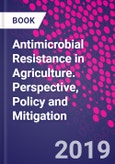Antimicrobial Resistance in Agriculture: Perspective, Policy and Mitigation is a valuable industrial resource that addresses complex, multi-factorial topics regarding farm, wild, companion animals, fish, and how the environment plays an important role in amplification and transmission of resistant bugs into the human food chain. Information of phenotypical and genotypical properties of each bacterial genus associated with antimicrobial resistance, transmission dynamics from different reservoirs (food animals, poultry, fishes) and control measures with alternative therapy, such as phytobiotics and nanomaterials are provided. Researchers, scientists and practitioners will find this an essential resource on the judicial use of antibiotics in animals and humans.
Please Note: This is an On Demand product, delivery may take up to 11 working days after payment has been received.








